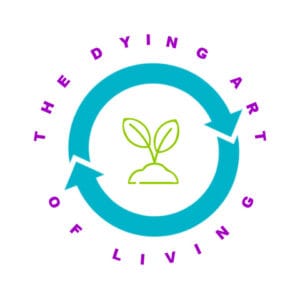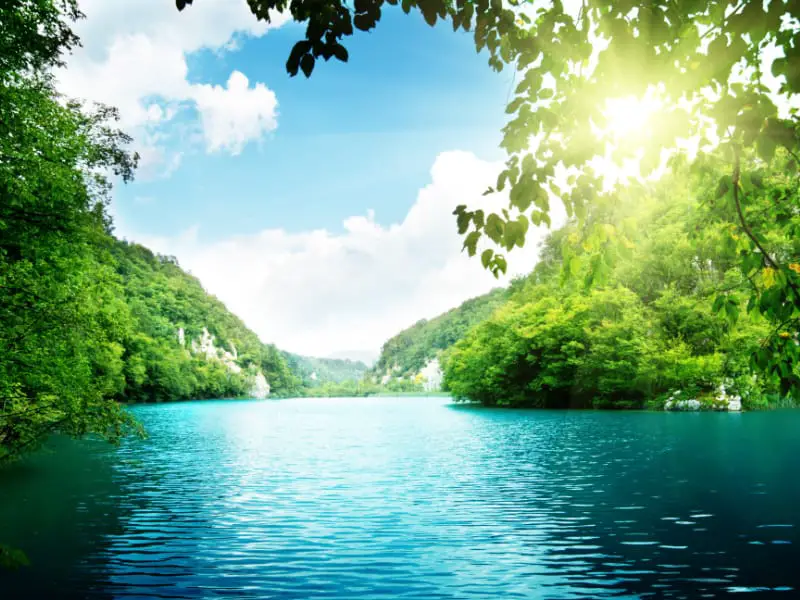

The vitality of water to human survival is second to none, capable of maintaining us for mere days sans consumption. Wilderness survival hinges on comprehending the essence of water, its potential safety concerns, and the strategies for its identification and detoxification.
Wilderness survival water sources include rivers, streams, and lakes, accessible through filtration, boiling, or chemical treatment. Additionally, rainwater collection, natural springs, and dew condensation on vegetation offer reliable alternatives for obtaining safe drinking water in remote outdoor environments.
A foundational comprehension of the perils posed by pathogens in untreated water and how their risks can be reduced is pertinent. Concurrently, an intimate understanding of how to secure and purify water in diverse wilderness environments can spell the difference between life and death.

Understanding The Importance And Safety Of Water Sources
Water And Its Importance For Survival
Water is crucial for human survival, involving almost every bodily function. From digestion and waste elimination to regulating body temperature, our bodies heavily depend on water to operate correctly. The human body is approximately 60% water, and since we lose water naturally through sweating and urination, it must be continually replaced. Without a consistent water intake, severe dehydration can set in within a few days, which, if severe enough, may lead to confusion, weakness, and other potentially life-threatening complications.
For more information about how much water you should drink daily, check out our post, How Much Water Should You Drink A Day.
Potential Dangers In Untreated Water
In wilderness survival scenarios, the importance of purifying water cannot be overstated. Natural water sources may harbor harmful pathogens like bacteria, viruses, and parasites. The most common of these, Giardia and Cryptosporidium, are hardy parasites resistant to many disinfection methods. E. coli bacteria may also be present, indicative of fecal contamination. Consuming untreated water can lead to diseases like dysentery, giardiasis, and Typhoid fever, causing moderate to severe gut infections. Additionally, water sources could be contaminated with chemicals or minerals that aren’t safe for consumption.
Minimizing Risk: Water Purification Methods
Minimizing these risks involves treating the water before drinking it. There are various effective methods for doing this.
- Boiling water for at least 1 minute is a simple yet highly effective way to kill most bacteria, viruses, and parasites. In higher altitudes, where the boiling point decreases, water should be boiled for at least 3 minutes to ensure safe drinking.
- Filters specially designed for hiking or backpacking are also a popular choice. These portable devices can filter out bacteria and parasites, but not always viruses. Be sure to understand the filter’s specifications before purchasing.
- Chemical treatments, like iodine or chlorine tablets, are lightweight and easy to carry but take longer to purify the water, usually 30 minutes to a few hours. They can also change the taste of the water and may not be effective against some parasites.
- UV light treatments are another option, especially against viruses, but they require batteries and can be less effective in murky or turbid water.
- Locating Water in the Wilderness
- Finding a water source in the wilderness is a survival skill everyone should know. Consider the landscape and its features; for example, valleys and low-lying areas are ideal places to find water. Watch for areas with lush vegetation or where animals are frequently seen, as these can be signs of a nearby water source.
In dry areas, digging into damp soil may yield a small amount of water. Try to locate where morning dew accumulates, or consider collecting rainwater if possible.
Remember, no matter the source, all-natural water should be treated before consumption to remove potential pathogens. Understanding the importance of water, the risks in untreated sources, and the methods of finding and purifying water can save your life when surviving in the wilderness.
For other articles you might be interested in, check out our posts, DIY Emergency Water Filter and How To Purify Water For Drinking.
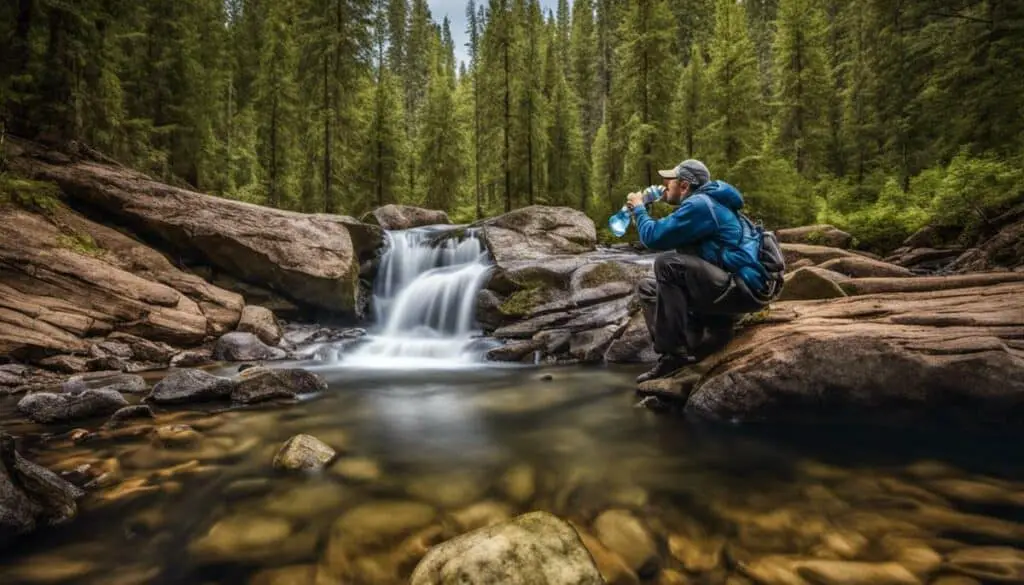

Locating Water In Different Environments
Understanding Water Basics For Survival
The human body can only survive for about three days without water, making it a critical resource in wilderness survival. Water sources can be found in most environments, but their accessibility and viability for use can vary greatly. It’s also crucial to remember that any sourced water should be treated or boiled before drinking to avoid waterborne diseases or parasites.
Surrounding Water Sources In Different Environments
In many natural environments, such as forests, mountains, and valleys, freshwater may be available in rivers, streams, ponds, and lakes. Look for moving water, as it’s typically safer to drink than stagnant water, which can be a breeding ground for bacteria and parasites.
Conserving Energy While Searching For Water
Energy conservation is critical in survival scenarios. Wandering looking for water can waste valuable energy needed for other survival tasks. Always prioritize your efforts based on your environment, sitting, and health condition.
Collecting Rainwater And Dew
Rain is an excellent source of clean water. If you predict rain, spread out containers or tarps to collect it. Aside from rain, dew that forms on plants overnight can also be collected as a water source. To gather dew, tie absorbent cloths around your ankles and walk through grass or undergrowth at dawn. The dew will soak the fabric, which can be wrung into a container.
Digging For Groundwater In Arid Environments
In arid environments like deserts, surface water may be scarce. However, groundwater can often be accessed by digging. Look for dry riverbeds or areas with lush vegetation, indicating underground water sources. Start digging a hole more expansive at the top than the bottom, around 12″ in diameter. The water may take some time to seep in, so be patient.
Using Snow And Ice As A Water Source
In frigid environments, snow and ice are water reserves ready to be tapped. Do not eat snow directly since it lowers body temperature. Instead, melt it first, either by fire or body heat. While ice and snow are generally clean, they can sometimes contain parasites or pollutants.
Utilizing Vegetation For Water
Certain plants can provide valuable water. Plants like the prickly pear or barrel cactus can be opened to reveal a moist, pulpy interior. Similarly, banana and plantain trees contain water in their trunk released when the tree is cut down. However, always double-check your plant identification, as some plants can be poisonous.


Water Purification Techniques In The Wild
Understanding The Importance Of Purifying Water In The Wilderness
In the wilderness, finding a water source is crucial for survival. However, simply finding water isn’t enough. It’s vital to purify the water before you consume it, as it can contain harmful bacteria, viruses, and parasites that can lead to severe illness if ingested. Different methods used for water purification include boiling, chemical treatment, filters, and solar methods.
Boiling Method For Water Purification
Boiling is among the safest ways to purify water. Here’s how to do it:
- Start a fire using whatever means you have available: matches, a lighter, or a fire starter.
- Put the water collected from your wilderness source into a heat-resistant container.
- Place the container over the fire and wait for the water to come to a rolling boil.
- Let the water boil for at least one minute. For higher altitudes (above 5,000 feet), extend the boiling time to 3 minutes.
- Once boiled, let the water cool naturally before consuming it.
Chemical Treatment For Water Purification
Chemical water treatment is another effective method using iodine tablets or chlorine dioxide tablets.
- Fill your container with water from your wilderness source.
- Add the correct number of tablets according to the manufacturer’s instructions.
- Stir the water to ensure the tablet dissolves completely.
- Let the water stand for at least 30 minutes to allow the chemical to eradicate bacteria and viruses.
Purifying Water Using Filters
Water filters are a handy method for water purification, as they mechanically remove pathogens from the water.
- Pour collected water into the filter’s input reservoir.
- Allow gravity to push the water through the filter, collecting the purified water in a separate clean container.
- Always follow specific instructions regarding maintenance and backflushing a filter to keep it functioning effectively.
Solar Purification Of Water
If you have no other tools, solar purification or disinfection (SODIS) is a good backup. The process is most effective in areas of high solar radiation.
- Fill a clear plastic water bottle with the water you’ve collected.
- Set the bottle to where it will receive full, direct sunlight. Laying it on a reflective surface, such as aluminum foil, can enhance the effect.
- Allow the water to sit in the sun for at least six hours on a sunny day or up to two days if the sky is partially cloudy. This time allows UV radiation from the sunlight to kill any pathogens in the water.
Through these methods, anyone in the wilderness can ensure they have access to safe, drinkable water. Ensuring proper elimination of harmful bacteria and viruses will protect individuals from water-borne diseases, which could be critical for survival in wilderness situations.
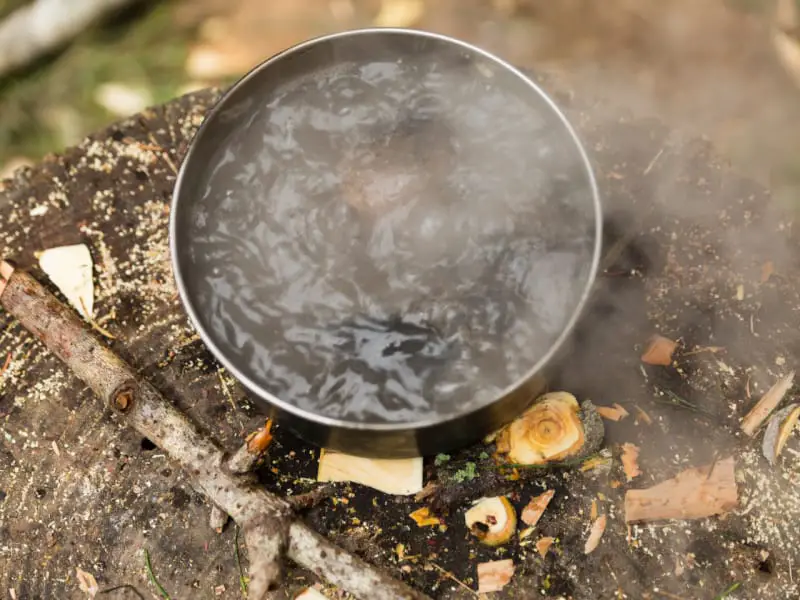

Emergency Water Procurement
Drawing Moisture From Plants
Without conventional water sources, plants can provide a viable option for hydration in survival situations. Plants store moisture in their structure, which can be carefully extracted and consumed.
To obtain water from plants, specific steps can be followed:
- Choose non-poisonous plants: many plant species store substantial amounts of water, but not all are safe. It is essential to learn to identify non-poisonous, water-rich plants such as cacti, grapevines, and certain types of grasses.
- Extract the water: once identified, cut a piece of the plant off and squeeze or mash it to release the liquid inside. Also, the water can be extracted by placing plant parts in a bag and letting them sit in the sun, allowing condensation to collect.
- Drink the water: collected water should be consumed promptly. It’s important not to eat the plant unless it’s safe.
Building A Solar Still
A solar still can collect and distill water from various sources, including soil and vegetation. This method maximizes the minimal available moisture in harsh conditions.
Constructing a solar still involves the following steps:
- Dig a hole: a pit around 3 feet wide and 2 feet deep, preferably in a moisture-rich spot.
- Place a can/cup: position a clean, empty container in the center of the hole. It will collect the condensation.
- Arrange green vegetation: line the hole with fresh, non-poisonous green vegetation or soil known to contain water. Avoid using poisonous plants, as their toxins can taint the water.
- Position a cover: place a sheet of plastic or a raincoat over the hole, sealing the edges with rocks or soil to prevent moisture escape. Then, place a small rock in the center of the plastic, allowing it to hang just over the collection container.
- Let it distill: as the sun’s heat evaporates the water from the vegetation or damp soil, it will condense on the underside of the cover and gradually drip into the collection container. After several hours, the container should contain drinkable water.
- Emergency water sources are vital when caught in unexpected wilderness survival situations. Both plant extraction and solar still construction are handy techniques that can save lives when conventional water resources are unavailable. While these techniques require a basic understanding of plant identification and simple construction skills, they are precious for survival in the wilderness.
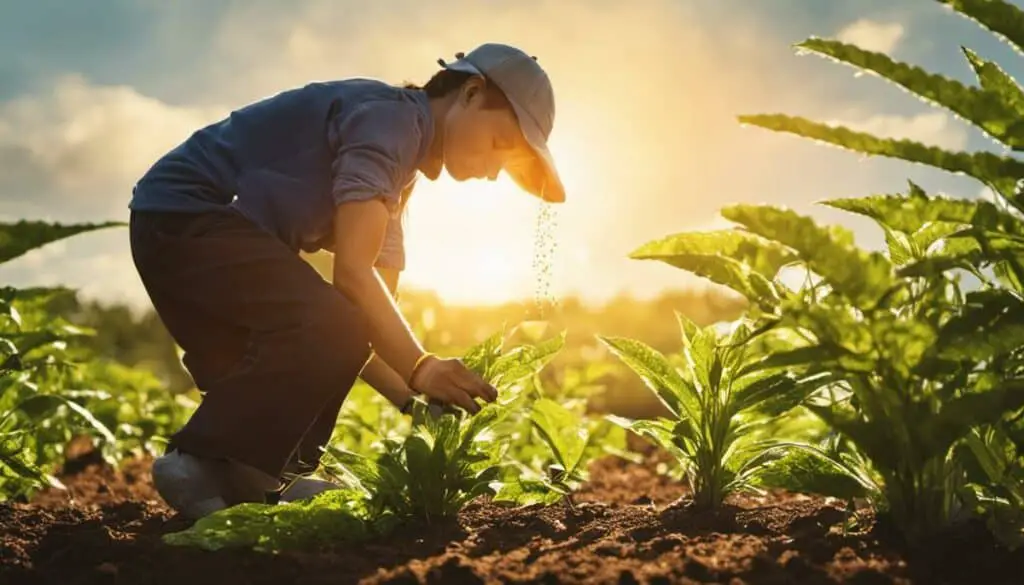

With the knowledge and toolkit you’ve acquired, finding and purifying water in a wilderness setting no longer needs to be a daunting task. Learning about emergency water procurement techniques like extracting moisture from plants and constructing solar still offers life-saving alternatives when traditional water sources are scarce. Always remember understanding and quick thinking are your best tools for survival. May your journeys in the wild be safe, and may you keep hydration at the forefront of your preparedness strategies.
I hope this post brought value to your day. Please consider sharing it with a friend or on your favorite social media if it did. Thanks For Reading The Dying Art Of Living!
